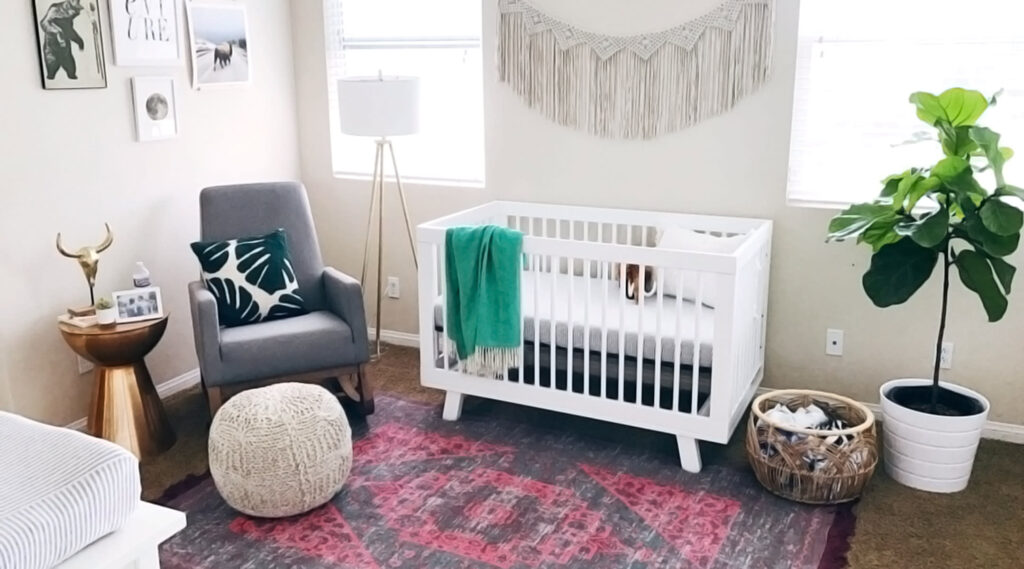A great crib should be versatile, well-built, and an eye-catching feature in your child’s room.
After dedicating 15 hours to researching numerous cribs and three days assembling and converting 10 different models, we found that the Carter’s by DaVinci Colby 4-in-1 Low-Profile Convertible Crib is the top choice for most families. This durable crib effortlessly transforms into a daybed, toddler bed, and full-size bed, ensuring it can adapt to your child’s needs for many years to come.
Everything we recommend
DaVinci Kalani 4-In-1 Convertible Crib

The best crib
This sturdy, traditional crib easily converts to a toddler bed and a full-size bed, offering versatility for years of use.
Most parents prefer to spend around $200 on a crib, and the solid, sturdy DaVinci Kalani stands out for its versatility and value at this price point. Made from sustainable New Zealand pine, this traditional-looking crib is GREENGUARD Gold certified for low emissions. It can be easily converted into a toddler bed with an optional half-width rail and can also transform into a full-size bed with an additional kit. Widely available in seven colors—white, gray, black, and four wood finishes—it’s easy to purchase without hefty shipping fees.
IKEA Sundvik
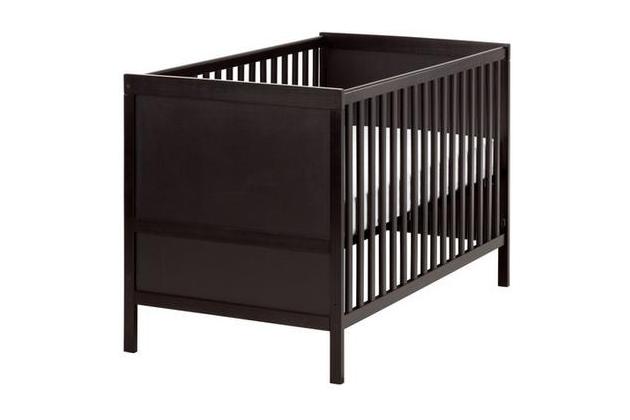
A simple, modern crib
This simple yet attractive crib is made from durable beech wood. However, it offers limited adjustability and cannot be converted into a full-size bed.
The IKEA Sundvik is a sleek, modern crib available in white, black-brown, or grayish brown, crafted from beech wood, which is typically stronger than the pine used in our top choice.
However, the Sundvik has two notable drawbacks compared to the Kalani: it offers only two adjustable mattress heights instead of four, and it cannot be converted into a full-size bed.
DaVinci Jenny Lind 3-in-1 Convertible Crib

Vintage style, modern colors
This uniquely designed crib features removable wheels, easily converts to a toddler bed, and is quick to assemble and convert.
The DaVinci Jenny Lind crib stands out with its retro spindle posts and wheels, making it easier to move than any other crib we tested. It’s the only crib with these features, and it’s also the simplest to assemble and convert into a toddler bed (with a separate kit). Available in vibrant colors like emerald green, cherry red, coral, navy, and lagoon blue, as well as classic white, black, and gray, it’s made from sustainable New Zealand pine and is Greenguard Gold certified for low VOC emissions. However, it may not feel as sturdy due to its spindle slats and legs.
Pottery Barn Kids Kendall Convertible Crib
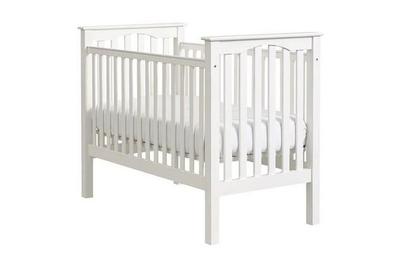
A super-sturdy hardwood crib
This higher-priced crib, constructed from solid poplar, features a robust design that is more resistant to nicks and dings compared to our other selections.
The Pottery Barn Kids Kendall Convertible Crib is crafted from solid poplar, making it more resistant to nicks and dings than softer pine. This classic-looking crib is easy to assemble and is Greenguard Gold certified for low emissions. Available in white, seadrift, weathered white, weathered navy, and gray, it’s ideal for those wanting a pristine appearance. However, it typically costs about twice as much as our top pick and does not convert to a full-size bed, although a toddler bar can be added (sold separately).
Who this is for

Babies need plenty of sleep, and the safest spot is a firm mattress in a safety-approved crib, as recommended by the American Academy of Pediatrics. Most parents buy a crib for their newborn, with some placing it in their bedroom initially, while others set it up in a nursery.
Research shows that families typically use a crib for about four years, converting it into a toddler bed or daybed when the child is around 2 to 3 years old. Some parents opt for cribs that can convert into a full-size bed for longer use.
How we picked

To determine which cribs to test, I created a spreadsheet listing about 30 manufacturers, from AFG Furniture to Westwood Design. I researched each brand’s cribs, noting prices, availability, and online reviews, using Baby Bargains and Consumer Reports as references. After eliminating 15 brands due to high prices, limited availability, or poor reviews, I added specific models from brands like IKEA, DaVinci, Graco, and Pottery Barn to our list. I also gathered feedback from parents, who frequently recommended IKEA, DaVinci, Pottery Barn Kids, and Graco cribs.

Based on research, expert and parent interviews, and personal experience, we determined a great crib should be:
- Safe: A crib should meet Consumer Product Safety Commission standards to ensure it’s safe for infants and toddlers. All cribs sold in the US comply with these requirements.
- Durable materials: The crib should be sturdy enough to last at least four years or longer, whether passed down or converted to a full-size bed. We considered the type of wood and materials used, noting Greenguard Gold certification for low VOC emissions, though its health benefits remain unclear.
- Affordable: Most parents are comfortable spending up to $200 on a crib. Higher-priced cribs often don’t offer additional value, so we considered overall cost, including toddler rails and shipping fees.
- Easy assembly and conversion: The ideal crib has clear instructions, is easy to assemble, allows for simple mattress height adjustments, and converts easily to a toddler bed, understanding that busy parents need convenience.
- Versatile and adjustable: A convertible crib that includes a toddler rail is a bonus. We preferred cribs with at least three mattress height levels to accommodate a growing child. Special features like wheels or a teething guard were also considered.
- Color and design options: We looked for cribs available in various colors and finishes, especially popular options like white, black, and gray. We also noted if the crib was part of a furniture collection and whether it was low-profile, which is beneficial for shorter parents.
I narrowed the list to eight crib brands with strong reviews and good availability. Six were affordable, and two were pricier but had great reviews, so we tested them in person. Choosing models like DaVinci’s Kalani, a top-rated crib with many reviews on Amazon, and the highly recommended Jenny Lind was easy. We also included Pottery Barn’s popular and budget-friendly Kendall Convertible Crib.

For some brands, we reviewed model specs and spoke with marketing reps to identify popular choices. From these discussions, we chose to test the Babyletto Hudson and the newly launched Carter’s by DaVinci Colby. After consulting with Storkcraft, Graco’s parent company, we selected the Solano crib over the older Lauren model for its compatibility with a universal toddler rail and extra features. We also tested the affordable Storkcraft Pacific. The Fisher-Price Newbury 4-in-1 Convertible Crib and IKEA’s popular Sundvik crib were added based on reviews and user feedback.
In the end, we tested 10 cribs, ranging in price from just over $100 to nearly $500.
How we tested
We had 10 cribs delivered to our Los Angeles office and assembled them over two days, despite a heatwave. With the help of an editorial assistant experienced in furniture assembly, we timed how long it took to put each crib together. While my assistant enjoys assembling furniture, I was a beginner, making the process a steep learning curve for me.
We unpacked each crib, counted the pieces, and followed the instructions to assemble them. After finishing, I recorded the assembly time and noted any confusing steps or mistakes we made. We discovered significant variation in assembly times: some cribs had only four parts and took just over 15 minutes, while most took around half an hour, and two cribs took over an hour to complete.
After assembling each crib, I inserted a mattress to ensure a good fit and checked its sturdiness. I moved, shook, and pulled on the crib, noting any easily damaged areas. We adjusted the mattress height for most cribs and tested the ease of converting our top picks to toddler beds and back. Alongside timing and rating the assembly process, I evaluated criteria such as price, materials, color options, and online reviews to determine our top picks.
Our pick: DaVinci Kalani 4-in-1 Convertible Crib

DaVinci Kalani 4-In-1 Convertible Crib
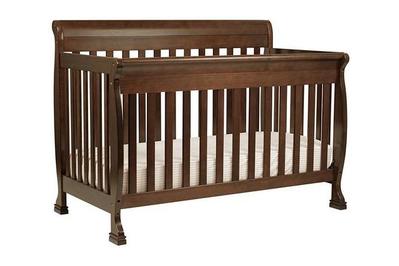
The best crib
This sturdy, traditional crib easily converts to a toddler bed and a full-size bed, offering versatility for years of use.
The DaVinci Kalani provides the best balance of sturdiness, quality materials, versatility, and price among the 10 cribs we evaluated. Priced at about $200, it offers excellent value for parents seeking a long-lasting crib. Greenguard Gold certified for low VOC emissions, the 56-pound crib is sturdier than other sub-$200 options, featuring thicker legs and sides. Additionally, it is the only one of our top picks that converts to a full-size bed.

The Kalani is constructed from solid New Zealand pine, a sustainable wood that, while soft and prone to dings, offers impressive sturdiness. Its design suits both traditional and modern interiors, and despite its larger appearance, it stands at only 35 inches tall from the floor to the top of the front rail—similar to some low-profile models we tested, making it easier for shorter parents to access. Available in white, gray, and black, as well as four wood tones from light honey oak to dark espresso (the most popular option with a rich sheen), the Kalani is the best-selling model from DaVinci (part of the Million Dollar Baby Company) and boasts excellent reviews from over 4,000 Amazon customers.
For an additional $80, you can buy a half-width toddler rail, and for about $100 more, a conversion kit is available, allowing the crib to transform into a full-size bed with the front and back serving as the headboard and footboard.

The Kalani crib consists of 14 pieces (excluding the mattress support) and took us over an hour to assemble, which was longer than our other picks. However, converting it to a toddler bed was much simpler, taking about 15 minutes. Moving the mattress support to one of the four height positions was also easy, providing more versatility compared to other cribs, most of which only had three heights or fewer.
Flaws but not dealbreakers
The DaVinci Kalani has two significant drawbacks. First, its assembly is overly complicated, involving 14 pieces compared to just four for most other cribs we tested. Unlike our other picks, which feature symmetrical designs for easier assembly, the Kalani has a sleigh-like design with different front and back pieces that must face a specific direction. While the pieces are labeled, the instructions rely too much on graphics instead of clear written directions. Additionally, the crib uses bolts of five lengths and requires an Allen wrench (included) and a Phillips screwdriver (not included), leading to frustration during assembly.

Most Amazon reviewers note that the Kalani takes about an hour to assemble, with our experience clocking in at 78 minutes—the second longest of the ten cribs tested, significantly longer than easier options.
A significant drawback is the softness of the New Zealand pine used in the crib. For instance, when I accidentally dropped a sleigh piece, a corner cracked off. Similarly, a screw fell during assembly, leaving a scrape on the wood. Many parents reported their children leaving teeth marks on the crib, leading some to buy teething guards. While most reviews are positive, many one-star ratings cite the easily damaged wood, with reports of cribs arriving scratched or cracked.
Despite its softness, New Zealand pine is consistent and sustainably sourced, meeting safety and strength regulations, making it a popular choice for cribs at this price point.
Also great: IKEA Sundvik

The IKEA Sundvik is a sturdy, modern crib available in white, black-brown, or grayish brown, made from stronger beech hardwood compared to the Kalani’s pine. However, it only offers two mattress height adjustments and does not convert into a full-size bed.
Many parents rave about the Sundvik for its reliability as a basic crib. I personally bought two for my twins, and they held up well for over four years, surviving moves and reassembly without issues. After converting them to toddler beds using the IKEA toddler rail, they remained in good shape. While they show some dings and minimal teething marks, the Sundvik is generally sturdier than other IKEA products I’ve owned, such as dressers, which have not fared as well.
IKEA’s cribs, including the Sundvik, are made from solid beech hardwood, which is stronger and more structural than pine, allowing for thinner slats. Unlike our other picks, the Sundvik also uses fiberboard—reconstituted wood fiber pressed together with heat and glue—for its solid side panels, sometimes referred to as MDF (medium-density fiberboard) and foil. In contrast, all the other cribs we tested feature slats on all four sides.

The Sundvik took two people just 25 minutes to assemble, significantly faster than the Kalani. The process was straightforward, mainly because the front and back are identical. However, adjusting the wooden and mesh mattress support was a bit frustrating due to its design, requiring two people to align the pieces without the crib falling apart. Converting it to a toddler bed, which involves removing the front side, also took another 25 minutes. The Sundvik collection includes other nursery items, and IKEA allows returns of undamaged items within a year. IKEA also offers other budget-friendly cribs, like the Sniglar for $130 and the Gulliver for $220, which have received positive reviews for their durability.
Also great: DaVinci Jenny Lind 3-in-1 Convertible Club

DaVinci Jenny Lind 3-in-1 Convertible Crib
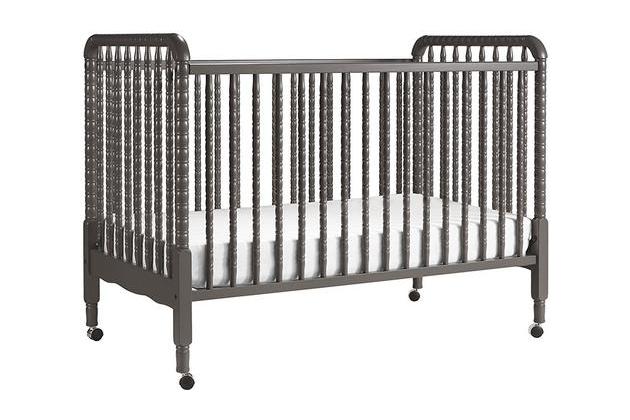
Vintage style, modern colors
This uniquely designed crib features removable wheels, easily converts to a toddler bed, and is quick to assemble and convert.
The DaVinci Jenny Lind crib stands out with its retro spindle design and functional wheels, making it the easiest crib to move around compared to others we tested. Weighing 45.5 pounds, it offers a wider variety of bright color options, including emerald green, cherry red, coral, navy, and lagoon blue, in addition to traditional white and wood tones. Constructed from New Zealand pine, it is Greenguard Gold certified for low VOC emissions, although it’s less sturdy due to its thinner slats and legs.
Assembly is a breeze, taking just 16 minutes for two people, making it the simplest among our picks. The toddler bed conversion can be done by one person in about 10 minutes. Like the Kalani, the Jenny Lind features four adjustable mattress heights. The wheels provide flexibility for parents in smaller spaces, allowing easy relocation for naps or bedtime. However, while they lack a locking mechanism, they can be removed if portability isn’t needed.

Upgrade pick: Pottery Barn Kids Kendall Convertible Club

The Pottery Barn Kids Barn Kendall crib is crafted from solid poplar, a durable hardwood less prone to nicks and dents than the softer pine used in other models. This classic-looking crib is relatively easy to assemble and is Greenguard Gold certified for low VOCs. Available in white, gray, and chocolate brown, the Kendall is ideal for those who want to keep their furniture looking pristine.

What distinguishes this crib from our other selections is its construction; while the DaVinci models use softer New Zealand pine and the IKEA crib combines beech and fiberboard, this heavy Pottery Barn Kids crib is crafted from solid poplar, weighing 59 pounds—more than any of our other picks. The Hardwood Handbook describes poplar as a hardwood that is “generally straight-grained and comparatively uniform in texture.” Designers from other brands noted that poplar is “a resilient, versatile wood” ideal for painted finishes, making cribs made from it much less prone to dings or marks compared to softer woods like pine.
In our assessment, the Pottery Barn Kids crib felt equally solid and sturdy as our top choice, the DaVinci Kalani, but it was clearly more robust and larger in profile than both the DaVinci Jenny Lind and IKEA Sundvik.

When we surveyed parents about crib brands, many named Pottery Barn Kids as their top choice. Personally, I know several individuals who have owned this crib for years, including my sister, who used it for her two active boys. She noted that it showed no bite marks or scratches and remained in excellent condition even after transitioning to Pottery Barn Kids bunk beds.
Assembling the crib, which comes in four parts, was simpler than our top pick; it took only 23 minutes. The transition to a toddler bed was also easy, taking about 10 minutes for one person, though installing the optional toddler rail would add a few extra minutes. The mattress can be adjusted to three heights, which is sufficient since most people typically adjust it only a couple of times. We appreciated the rounded mattress supports, which are easy to level and nearly invisible once the mattress is in place, unlike the visible straight bars in many other cribs.
The main downside is the price; while it retails for $600, sales often bring it down to $500. Shipping costs $25, or you can pay $160 for home delivery and assembly. The toddler rail is an additional $200, and experts recommend purchasing it alongside the crib to avoid potential model or color changes later. Unlike our top pick, the Kendall crib does not convert to a full-size bed.
The larger Pottery Barn Kids Kendall collection includes a variety of matching furniture, such as standard and extra-wide dressers with optional changing pad toppers, a nightstand, a desk with a hutch, and bunk beds that convert to two full-size beds. Returns are accepted within 30 days.
